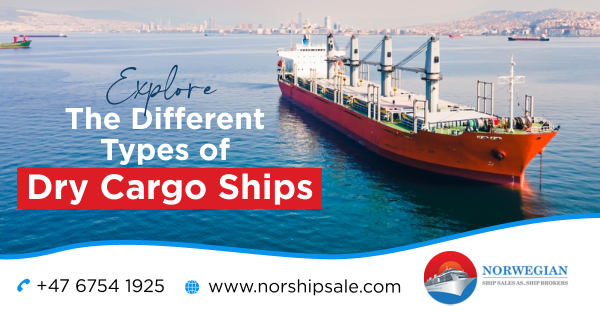At present, commercial vessels are available in various shapes and sizes. These are engineered differently so that they can carry different types of freight. Whether the cargo is dry, specialized cargo, or liquid cargo, there are specific vessels that can carry it. To give an example, dry cargo is carried by container vessels, bulk carriers, and other types of ships. In this blog, we have taken the initiative to discuss all the types of ships that carry dry cargo. It is important to point out that only well-built ships offer all the benefits that they are designed for, so if you are considering buying a ship for sale in Norway or elsewhere, make sure that you get in touch with top shipbrokers.

5 Types of Dry Cargo Ships
Here is everything that you need to know about the five different types of dry cargo ships that you can invest in successfully.
1. Ro-Ro Vessels
Roll-on/roll-off or Ro-Ro vessels are made mainly to carry rolling cargo, such as cars and other vehicles. These ships are equipped with specialized ramps and car decks that enable vehicles to be driven onto and off of the vessel, facilitating quick and easy loading and unloading.
Ro-Ro ships are frequently used to transport large machinery, big trucks, and autos. They are essential to the smooth flow of automobiles from manufacturers to dealerships and end users in the automotive and logistics industries.
Norway’s large coastline and robust automotive sector make it a significant market for Ro-Ro vessels, which may be of interest to those looking for ships for sale in Norway.
2. Bulk carrier
The workhorses of the dry cargo transportation sector are bulk carriers. These ships are made to carry vast amounts of dry bulk cargo, such as coal, iron ore, cereals, and different minerals. Large cargo holds and huge cargo-carrying capacities are hallmarks of bulk carriers. They range in size from little handy-sized boats to enormous Cape size ships that can transport more than 400,000 deadweight tons (DWT) of freight.
Bulk ships frequently have self-unloading technologies, which enable them to quickly unload cargo at ports with sparse infrastructure. As a result, they are very effective in moving goods like coal and iron ore between power plants and steel mills. Due to Norway’s long history of exporting natural resources and transportation, bulk carriers are routinely offered for sale in the marine market there.
3. General Cargo Vessels
Bulk products, breakbulk cargo, containers, and other cargo can all be transported by general cargo ships, often known as multipurpose vessels. Due to their versatility in loading and unloading methods and ability to adapt to various cargo types, these ships are valuable assets in the maritime industry.
To carry a variety of cargo, general cargo ships may contain various cargo holds and movable cargo handling machinery like cranes and forklifts. They are frequently used to transport machinery, project cargo, and other non-standard commodities that are difficult for container or bulk carriers to manage.
Due to their adaptability, general cargo ships are present in numerous ports across the world, including those in Norway, where they are widely employed for local trade and shipping commodities to and from Northern Europe.
4. Container Vessels
The world of maritime transportation has been completely transformed by container ships. These ships are made to transport uniform containers that are simple to load and unload using cranes and other handling tools. Containerization has made it possible to transport a variety of commodities in a very effective and secure way, from consumer electronics to apparel and furniture.
From tiny feeder ships to enormous ultra-large container ships (ULCS) that can transport more than 20,000 twenty-foot equivalent units (TEUs) of cargo, container ships come in a variety of sizes. The development of ULCS has significantly boosted container ship capacity, allowing for the effective transportation of products on a global scale.
The strategic location of Norway as a gateway to Europe makes it a popular place for container ship trade, both for new and old ships.
5. Reefer Vessels
The reefer ship is a distinct type of cargo ship. It is used to transport commodities that, as the name implies, require constant refrigeration or in situations where the cold chain cannot be disrupted. Despite the fact that fruit, such pineapples, bananas, and other tropical fruits, can also be delivered on a refrigerated ship, the majority of the time these products are meat or fish.
Conclusion
In conclusion, the dry cargo shipping industry is diversified, with numerous vessel types created to efficiently convey various sorts of goods. There is a dry cargo ship made to fit your transportation demands, whether you’re moving bulk goods, containers, general cargo, rolling cargo, or specialized cargo. Given Norway’s long maritime history and advantageous location, you’ll probably find a large selection of options if you’re looking for ships for sale in Norway. When choosing to buy or rent a ship for your shipping operations, you’ll want to be well-informed about the many types of dry cargo ships, and more things, which is why you should.

